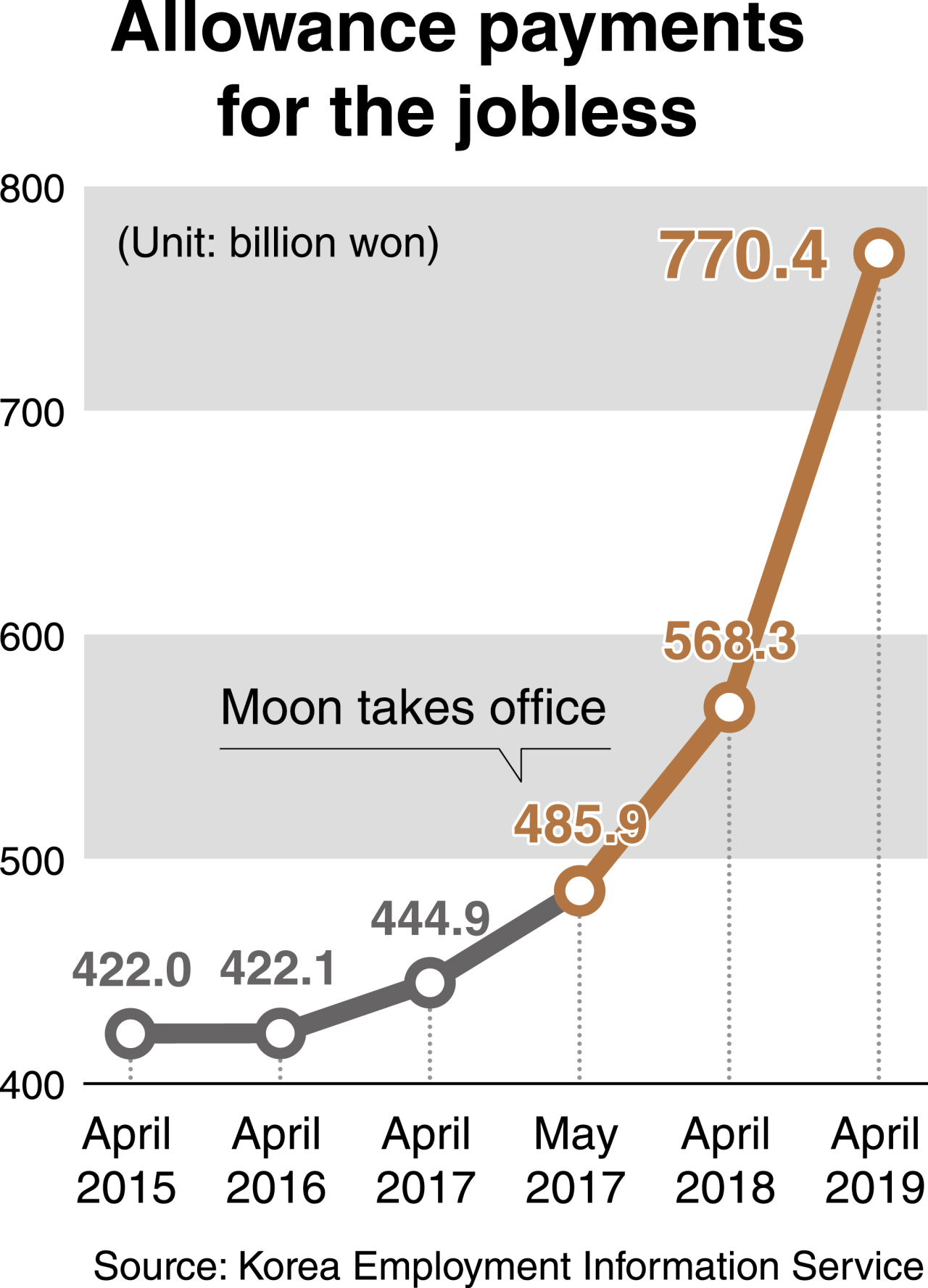[News Focus] Unemployment-benefit payment surges 58% during Moon’s term
By Kim Yon-sePublished : May 28, 2019 - 16:31
The number of South Koreans applying for unemployment benefit (also dubbed job seekers’ allowance) have rapidly increased in the wake of widespread small business closures and rising jobless rates.
According to the Ministry of Employment and Labor, the unemployment rate as of April 2019 came to 4.4 percent, higher than the 3.8 percent recorded both in April 2014 and April 2009.
According to the Ministry of Employment and Labor, the unemployment rate as of April 2019 came to 4.4 percent, higher than the 3.8 percent recorded both in April 2014 and April 2009.

According to the Korea Employment Information Service, the government’s monthly payment of unemployment allowances reached 770.4 billion won ($649.8 million) in April. This is the highest since the nation began to release figures on the payments in 1997.
It also marked a 58.5 percent increase since President Moon Jae-in took office in May 2017, when total job seekers’ allowance bill stood at 485.9 billion won.
After exceeding the 500 billion-won mark in March 2018 for the first time in history, the monthly payment broke through 600 billion won in October 2018.
Further, last month’s figure posted a 97.1 percent jump from five years ago: the payment was 390.7 billion won in April 2014. And it stayed at 422.0 billion won in April 2015, 422.1 billion won in April 2016 and 444.9 billion won in April 2017.
Data showed that the number of recipients for the allowances also hit a record in April 2019, at 529,703.
By region, residents in Gyeonggi Province topped the list with 133,183, followed by Seoul at 99,684, Busan at 41,047, South Gyeongsang Province at 35,513, Incheon at 33060, North Gyeongsang Province at 27,987 and Daegu at 25,586. Sejong and Jeju Province posted the fewest and the second-fewest with 2,669 and 5,349
By generation, recipients in their 50s held the largest proportion with 25.2 percent, trailed by those in their 60s with 21.2 percent, those in their 40s with 20.2 percent, those in their 30s with 19.2 percent and those in their 20s with 13.4 percent.
Women outnumbered men among benefit claimants in the month, accounting for 52 percent of the total.
Claimants sharply increased among those, who had worked in the construction and lodging-restaurant sectors. The number came to 63,000, up 32.7 percent from a year ago for the construction and 29,000 for the lodging-restaurant, up 18.5 percent.
An official of the Employment Ministry cited the massive business closures of among the self-employed in the lodging-food sector for the reason. The closure ratio -- the ratio of business closures to startups -- has recently posted about 80 percent.

A research analyst in Seoul said the increase in benefit payments for the jobless “is somewhat attributable to a drastic hike in the statutory minimum wage,” which shot up 29 percent in recent two years.
He said labor standards stipulate that the floor the allowance payments is 90 percent of the minimum wage.
On a yearly basis, total benefit payments reached 6.68 trillion won in 2018, up 27.5 percent from 5.24 trillion won a year before. The amount stayed under 4 trillion won from 2010 to 2013, and under 5 trillion won from 2014 to 2016.
The number of recipients was 1.391 million in 2018, up 9.2 percent from 1.273 million a year before. While the number stayed below 1.3 million between 2010 and 2017, the yearly recipient number is projected to rise more by the end of 2019, according to labor market insiders.
Statistics Korea data showed that the number of jobless people came to 1.245 million as of April 2019. This is a 25.1 percent climb during President Moon’s last term of 23 months since May 2017, when the number of unemployed posted 995,000.
By Kim Yon-se (kys@heraldcorp.com)









![[Kim Seong-kon] Democracy and the future of South Korea](http://res.heraldm.com/phpwas/restmb_idxmake.php?idx=644&simg=/content/image/2024/04/16/20240416050802_0.jpg&u=)







![[KH Explains] Hyundai's full hybrid edge to pay off amid slow transition to pure EVs](http://res.heraldm.com/phpwas/restmb_idxmake.php?idx=652&simg=/content/image/2024/04/18/20240418050645_0.jpg&u=20240418181020)

![[Today’s K-pop] Zico drops snippet of collaboration with Jennie](http://res.heraldm.com/phpwas/restmb_idxmake.php?idx=642&simg=/content/image/2024/04/18/20240418050702_0.jpg&u=)